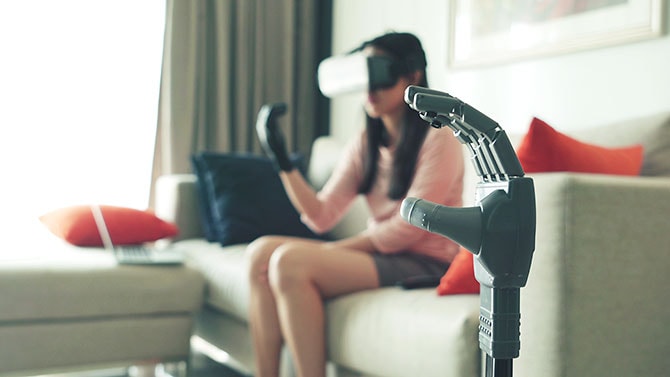The ‘new normal’ business environment
Overview
The corporate and business world has experienced several significant events over the years. Ranging from financial crises to political events and health crises, such as the COVID-19 pandemic.
In taking steps to resolve the health crisis, many have reimagined the new normal in a world that is now more inward-looking than before.
Consequently, contingency planning and incorporation of the uncertainty around future events has become a core consideration in decisions taken by companies.

Productivity and efficiency have also been brought to the fore during this pandemic which presents opportunities for automation and smarter ways of working, which thrive in a virtual society.
It has become evident that the previously ‘established’ way of doing things was impacted and companies thriving in this situation were the ones that were willing and able to re-adapt and remodel to take advantage of their strengths and create new opportunities in this post-crisis world.
This involved a longer-term focus in relation to the decisions taken by businesses, increased use of the internet in online marketing and e-commerce activities.
Other key themes in the response to this pandemic revolved around the ability to harness information processing capabilities to derive insights into the ripple effects of the pandemic on market forces, competition, business reengineering as well as future trends.
It is evident that the world is changing swiftly as uncertainty surrounding trade, economic growth, regulations and geopolitics looms. At the same time, the Fourth Industrial Revolution (4IR), also known as Industry 4.0 can open opportunities for growth even during economic downturns through greater productivity and efficiencies.

Fourth Industrial Revolution (4IR)
The Fourth Industrial Revolution (4IR), also known as Industry 4.0, is the unfolding age of digitalization—from the digitally connected products and services we consume, to advancements in smart cities and factories and increasingly common automation of tasks and services in our homes and at work, has finally come of age and it’s pervading virtually every aspect of modern life. From consumers to manufacturers to cities, 4IR advancements are more accessible and less costly than just a few years ago but 4IR is more than technology: as it gradually shapes how we live and work (and even play), it also ushers in a revolution of experience.
Imagining Smart Manufacturing – looking beyond COVID-19
Globally, the modern factory is already a highly complex environment.
The promise — if not the full reality — of the Fourth Industrial Revolution (4IR) has pushed a few leading organisations to digitise virtually every aspect of manufacturing. In such environments, advanced machines and robots are equipped with a wide array of sensors connected to high-powered analytics engines in the cloud that assess performance, manage production schedules, maintain supplies and orchestrate all the activities on the factory floor.
Most of the technologies on which the Fourth Industrial Revolution (4IR) depends are in place — at least in theory: Advanced robotics and 3D printing, artificial intelligence (AI) and machine learning, sophisticated sensors and the Internet of Things (IoT), cloud computing, advanced data analytics, virtual and augmented reality. Most manufacturing companies understand the value of these technologies whether they are in the supply chain, in production processes or incorporated into the products and services sold to customers, however only a few have made the big bets necessary to implement these technologies throughout their operations.
In Ghana, where the concept of the 4IR is still being processed, imagine that factory transformed by the implementation of 5G networking. The significantly greater speeds of 5G — up to 10 Gbps, far faster than wi-fi — and its near-zero latency should alleviate concerns about the speed and reliability of earlier wireless protocols as observed in environments that have experienced 4IR. By eliminating the need for wired connectivity, 5G will supplement the high-speed manufacturing environment with a far greater degree of flexibility. The sheer richness of the 5G-enabled factory, which will have the capacity to maintain connections among far more sensors than either wired or previous wireless facilities, offers the potential to connect just about anything.

Key Steps to an effective pandemic response
As manufacturers contemplate this ‘factory of the future’, however, the scope of the problems from COVID-19 may seem daunting, especially as the world experiences the third wave, particularly for industrial manufacturers with integrated global supply chains and complex operating environments. But that’s no excuse for inaction. For governments, businesses and institutions, the essential elements of a high-level response are quite similar.
- Repair
- Rethink
- Reconfigure
- Report
- Restart
Repair
First, stakeholders need to fix the economic damage of the crisis. Governments must address increased national debt, a reduced tax base, and higher short-term spending. Businesses will need to address vastly weaker balance sheets, steep revenue declines and, in many cases, weakened supply chains and stressed or depleted employee bases, given reduced staff numbers to ensure physical distancing.
Rethink
Both governments and businesses need to review their response to the pandemic, understand best practices, and prepare for the next inevitable crisis. Companies must rethink their operating model, supply chain and business model. Countries need to consider what is essential to localise for reasons of security, economy and crisis management. More broadly, both nations and organisations need to rethink what success means, identifying new measures of material, social and environmental progress that can guide our efforts.
Reconfigure
Organisations must make the systemic rethinking concrete by reconfiguring public and business institutions. This represents a much more fundamental redesign of organisations than the repair process entails. The crisis has put into strong relief the uncomfortable truth that a host of institutions around the world are simply not ready for the 21st century. It’s essential that systems including healthcare, legal, education and taxation be reconfigured to become more efficient, effective and resilient.
Report
In a period of great uncertainty, people will call for more transparent information on a broader range of issues. Investors, regulators and stakeholders will demand more disclosure and information in real time on everything from cash flow to the health of employees.
Restart
A host of organisations — in both the public and private sectors — will need to restart in a changed world, because they were either shut down owing to government fiat or forced to for financial reasons. The need to restart can happen at any point in the repair-rethink-reconfigure process. As uncertainty grows around the world, this process becomes the new normal: the next crisis will occur, and organisations that have not learnt the lessons of this experience will be back in repair mode.








